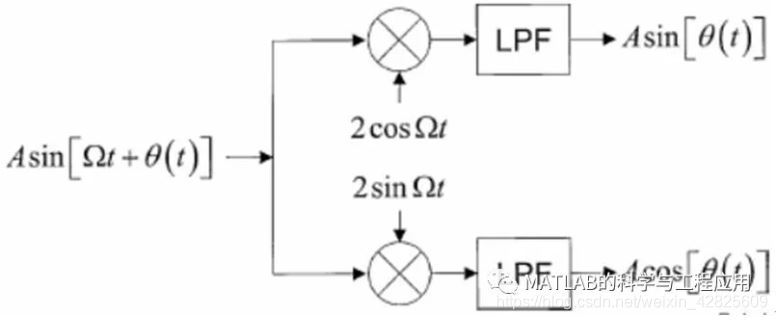【讀書2】【2014】基於MATLAB的雷達訊號處理基礎(第二版)——接收機(1)
1.3.3. 接收機
1.3.3. Receivers
第1.3.1節指出,雷達訊號通常是窄帶、帶通的相位調製或頻率調製訊號。
It was shown in Sec. 1.3.1that radar signals are usually narrowband, bandpass, phase- orfrequency-modulated functions.
這意味著單散射點的雷達回波表示式r(t)為:
This means that the echo waveform r(t)received from a single scatterer is of the form

其中幅度調製A(t)表示脈衝包絡。
where the amplitude modulation A(t)represents only the pulse envelope.
接收機處理的主要功能是將雷達訊號的承載資訊解調到基帶,其目的之一是測量θ(t)。
The major function of the receiverprocessing is demodulation of the information bearing part of the radar signalto baseband, with the goal of measuring θ(t).
圖1.9描述了大多數經典雷達中使用的接收機設計的傳統方法。
Figure 1.9 illustrates the conventionalapproach to receiver design used in most classical radars.

圖1.9 傳統的正交通道接收機模型,圖中的下通道為同相I通道,上通道為正交相位Q通道Conventional quadrature channelreceiver model. In this illustration, the lower channel is the in-phase(“I”) channel, and the upper is the quadrature phase (“Q”)channel
正交接收機中的訊號被分離為兩個通道。
The received signal is split into twochannels.
在雷達工作頻率上,稱為同相I通道的訊號與本振LO進行混頻。
One channel, called the in-phase or"I" channel of the receiver (the lower branch in Fig. 1.9) mixes thereceived signal with an oscillator, called the local oscillator (LO), at theradar frequency.
混頻產生和頻、差頻:
This generates both sum and differencefrequency components:

採用低通濾波器可以濾除掉和頻,從而只保留差頻調製項A(t)cos[θ(t)]。
The sum term is then removed by the lowpassfilter, leaving only the modulation term A(t)cos[θ(t)].
正交相位Q通道經過混頻後具有與I通道相同的訊號頻率,但會產生90度的相移。
The other channel, called the quadraturephase or “Q” channel, mixes the signal with an oscillator having thesame frequency but a 90° phase shift from the I channel oscillator.
Q通道混頻器輸出為:
The Q channelmixer output is

Q通道經過低通濾波後,得到的調製項為A(t)sin[θ(t)]。
which, after filtering, leaves themodulation term A(t)sin[θ(t)].
如果輸入訊號r(t)為A(t)cos[Ωt + θ(t)],則圖1.9中的上通道成為同相I通道,下通道成為正交Q通道,低通濾波後的輸出分別為A(t)cos[θ(t)]和–A(t)sin[θ(t)]。
If the input r(t) is written as A(t)cos[Ωt+ θ(t)] instead, the upper channel of Fig. 1.9 becomes the I channel and thelower the Q channel, with outputs A(t)cos[θ(t)] and –A(t)sin[θ(t)],respectively.
I通道是指本振訊號與輸入訊號相同的通道。
In general, the I channel is the one wherethe oscillator function (sine or cosine) is the same as that used in modelingthe signal.
採用I通道和Q通道解調的原因在於,單獨一個通道不能提供足夠的資訊來明確地確定相位調製θ(t)。
The reason that both the I and Q channelsare needed is that either one alone does not provide sufficient information todetermine the phase modulation θ(t) unambiguously.
——本文譯自Mark A. Richards所著的《Fundamentals of Radar Signal Processing(Second edition)》
更多精彩文章請關注微訊號:
